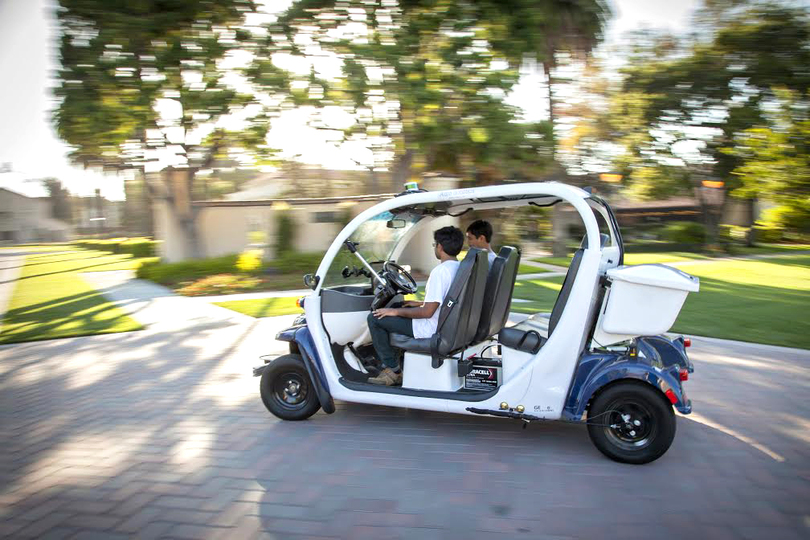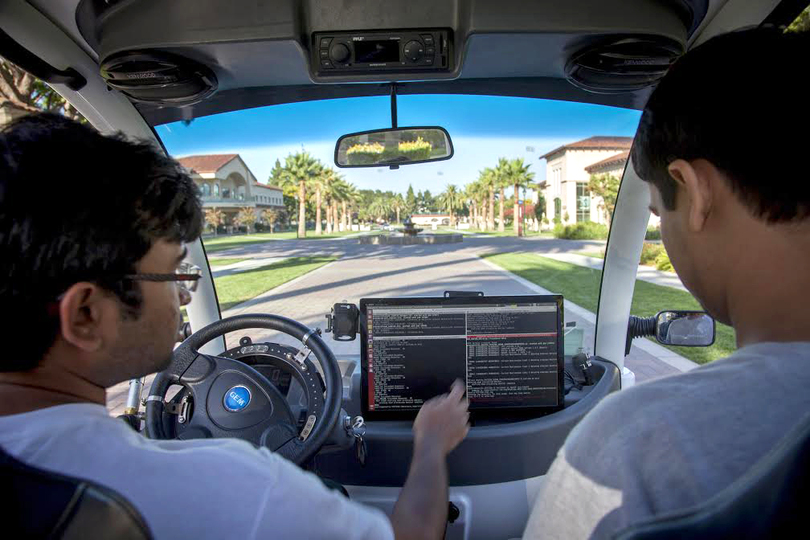Silicon Valley start-up tests driverless shuttles at Santa Clara University
Driverless cars may be coming in the near future.
Auro Robotics, a Silicon Valley start-up headquartered in Sunnyvale, California, has pioneered a new driverless shuttle that is currently undergoing its first trial run at Santa Clara University.
The electric shuttles, which Christopher Kitts, associate professor of mechanical engineering and head of the robotics program at SCU, described as “supped-up golf carts,” use laser scanners and cameras to generate a complete 360-degree view of their surroundings, according to a release from SCU.
The shuttles can start and stop autonomously, and are able to recalculate route, speed and direction when they sense pedestrians in their path.
As part of the pilot program that begins this fall, engineers will ride in the vehicles over the course of three months to monitor “technology and safety as well as the user experience,” according to the release.
As a test arena, SCU was no accidental choice, Kitts said. Auro Robotics approached the private institution because of its ideal pedestrian campus and ability to bypass government approval and move quickly.
Additionally, SCU is in a prime location for Silicon Valley ventures.
“There’s a lot of interest in SCU from being in Silicon Valley,” Kitts said. “We are part of the fabric and get to interact with it.”
As a professor, Kitts said he is excited for his students to interact with a company making some serious waves in the robotics field.
“Auro Robotics is using very innovative technology, which gets my interest from both the robotics point of view and innovation point of view,” he said. “For the students in my lab, having them see a professional version of this up close and personal is pretty interesting.”
SCU and Auro will further collaborate this semester as part of the university’s innovation and entrepreneurship program, which aims to expose students to industry professionals via a series of extracurricular activities.
This year’s agenda for the program includes a technical seminar, an industry design challenge and an industry mentor reception, all of which are in collaboration with Auro Robotics, Kitts said.
Christopher Shay, vice president for operations at the university, said in an email that he is excited to have the autonomous driver technology on campus for its ability to accommodate almost anyone, whether it is “an injured athlete, a staff member with mobility concerns or an elderly patron of the arts.”
“This mobility, while very useful for the average individual, would revolutionize movement for students/staff/faculty/visitors that need assistance,” Shay said.
The shuttles, which have yet to carry their first student passengers, are still in the process of system calibration. The vehicles are without riders so engineers can tune the systems and integrate a map of campus. The university has worked closely with Auro in finding time for these isolated trial runs.
“We invite the engineers onto campus to test the vehicles under strict protocols,” Shay said. “We look for a period of time like the summer or later in the day when the campus traffic is slightly less than normal. The Auro Robotics engineers then spend the day testing out improvements in software from the previous day’s development cycle.”
As for taking a ride in the futuristic vehicle, Shay said his turn is coming up very soon.
“Nalin (the CEO and co-founder of Auro) has me scheduled for next week. I’ll be one of the first Santa Clara staff to take a ride.”
Published on September 9, 2015 at 10:15 pm
Contact Brigid: brkenned@syr.edu







